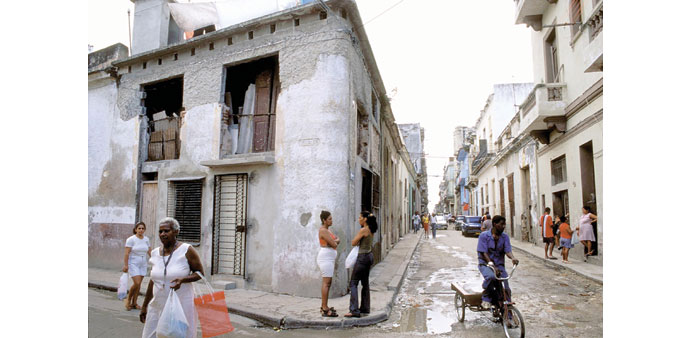By Steff Gaulter
There’s so much nostalgic charm surrounding Cuba. Mention the country to most people I know and they will talk about the beautiful old cars, the fabulous cigars and the bars that served Ernest Hemingway his famous mojitos.
People in the UK advise each other to “Go before they open a McDonald’s!” Despite how that may sound, it’s not actually a slur on the Golden Arches, it’s just a way of saying, it’s different. The advice is to go before Cuba opens its doors to the huge multinational companies, not just McDonald’s but the likes of Nandos, Apple and Zara Home; in other words before it offers the same as almost every other country around the globe.
Its unique appeal is often enjoyed in sultry weather, but some weeks are definitely hotter than others. Two weeks ago, the island of Cuba suffered the extremes of weather. First came relentless heat, and this was followed by torrential rain. The heat reached a peak on April 26, when the temperatures soared higher than ever before in Havana. A new record maximum of 37.0C (98.6F) was reported in the capital, but elsewhere it was even hotter. The eastern city of Holguin reported a sweltering 38.7C (101.6F), which narrowly missed being the hottest temperature ever recorded anywhere in the country.
These temperatures might not sound too impressive for us living in Doha, but remember that we live in a country which is prepared for the heat. We live in air conditioned homes, drive air conditioned cars and work in air conditioned offices. Cuba is very different. Air conditioning is far less common, and many homes and vehicles are without the luxury. Without a means to cool down, temperatures over 35C (95F) can be dangerous, particularly to those who are sick or very old.
Cuba’s record-breaking heat is even more surprising given the time of year. Traditionally the hottest months in the Caribbean are July and August, yet this heatwave struck in April. April is spring in the country, not even in summer, and certainly not the time of year you’d expect to endure a city’s highest-ever temperature. The heat was oppressive and unbearable, and its end was dramatic. Thunderstorms rattled across the country, bringing a swift change to the weather. The temperature dropped 8C in less than 45 minutes, but the relief was short-lived. The cooler air, being dramatically different from the hot air, reacted explosively, bringing damaging winds and torrential rain.
The winds howled up to 98 kph (61 mph) and the rain was relentless. Casablanca, situated to the east of the entrance to Havana Harbour, reported 188mm (7.4 inches) of rain in just 24 hours. The Cuban capital usually expects about 58mm (2.3 inches) of rain in the entire month of April, so it’s hardly surprising that more than three times that in a single day caused major problems. Flooding across the capital killed at least three people as the storm caused three buildings to collapse and triggered widespread power cuts.
Clearly here in Qatar we have a huge connection to Cuba— the Cuban hospital in Dukhan is one of the best hospitals in the country. My Spanish speaking friend told me that the staff talk about returning to Cuba laden with gifts that their family members could only dream of. Their list of presents doesn’t include items such as iPhones and laptops, it’s simple things, like olive oil and strawberries.
My husband and I visited Cuba last year. To try to experience the ‘real’ Havana, rather than just the tourist side, we opted to stay in a ‘casa particular’. These are family-run bed and breakfasts, as opposed to one of the big hotels. When we were trying to book the room, we were frustrated by the amount of time it was taking the owner to reply to our e-mails. However, when we got to Cuba, we realised how foolish we’d been to expect a reply at all. While the rest of the world is busy doing everything on the internet, Cuba still has huge restrictions. In order to use the web, we had to go to one of the big hotels and buy a few minutes of internet access. It certainly wasn’t cheap.
Despite the difficulties in making the reservation, the casa particular we stayed in was ideal. It was located on one of the floors of one of the fabulous old buildings right on the seafront, and like the majority of buildings in Havana, it was brimming with character. A visit to the city really was like stepping back in time, surrounded by fabulous Spanish colonial architecture and beautiful old cars. However, there was a clear price that the locals were paying for the country’s old world charm.
The buildings may once have been stunning, but the crumbling facades were begging for restoration and everywhere we looked there were signs that the locals were struggling to make ends meet. This would make it very difficult for the locals to recover from the recent flooding. Most people would not have insurance, so their lost possessions would be almost impossible to replace.
This goes to show that living in Cuba is a long way removed from the romantic notion that many people may have of the island. It’s one thing to visit, but it would be another matter to live there, and perhaps that’s something we should remember the next time we tuck into a bowl of strawberries.

RUSTIC: This file photo from 2002 shows street scene at the Old Havana (La Habana Vieja), a Unesco World Heritage Site. Photo by Jialiang Gao


